Today we are going to look at the culture that inspired some of the most unique rivals. Japan created many of the the best fighting titles, this cannot be argued. Part of their success was due to being at the right place at the right time. The genre was relatively young in the mid '80s and every idea was fresh and unique. As soon as the developers figured out that a fighting game could be more than video boxing the world opened up. We can credit the various Japanese studios for many other "firsts." They were the first to place fighters from different martial arts schools against each other. They created a narrative for the main characters. They added a way to track health, the ability to perform special attacks and even the ability to destroy the environment on each stage. These details helped pull the audience into the experience. The character designers working on these titles were influenced by a number of sources. Many of the early fighting game heroes were based on movie characters or even popular real world fighters. Some were based on tough guy archetypes. In Japan one of the popular tropes was the young rebel, a sort of gang leader that talked with his fists.
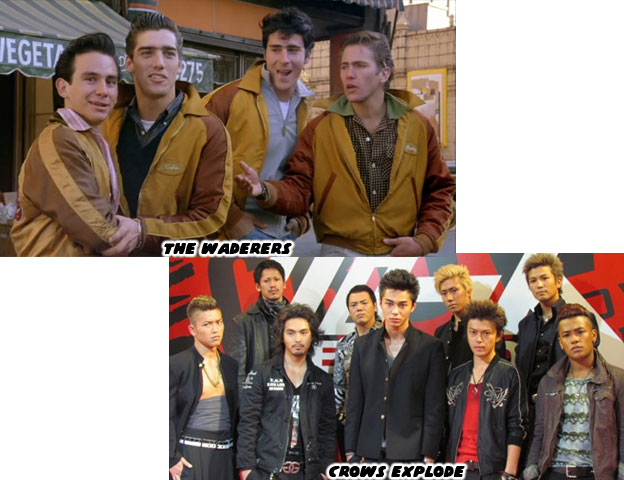
Movies about gangs, coming-of-age, fighting and violence are nothing new. The whole rebel identity is celebrated around the world, especially in pop culture. Cult movies like the Wanderers in the USA and modern films like Crows Explode in Japan capture a portion of the colorful and sometimes brutal side of life in a dysfunctional (rather than dystopian) society. The gang leader with a powerful sense of loyalty is someone to be admired. It doesn't matter if this is a novel, short story or comic book figure. There are actually many positive features with the rebels in these works of fiction. In the USA the leather clad motorcycle rebels from the '50s, the "greasers" were one such archetype. Often they were runaways, young enough to be in school they often rejected authority. They felt smothered by the establishment and wanted to be free to the run the streets. They lived hard, loved hard and fought hard. They were essentially the replacement for the open range "cowboy" from the previous century. Hollywood told their story and in the process they created icons like James Dean in film and The Fonz on TV. In Japan there was a variation of the heroic rebel as well. These figures were often modeled after high school delinquents.
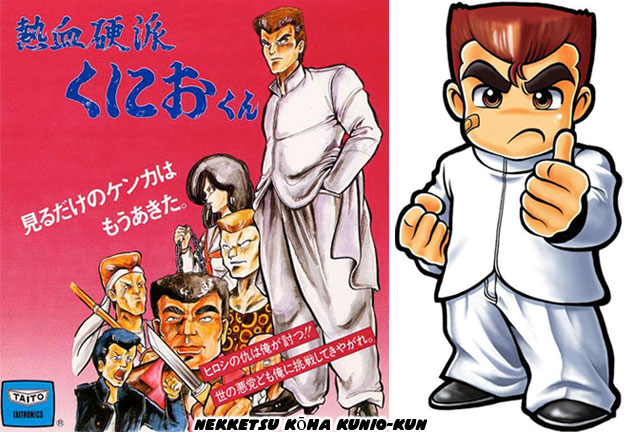
In Japan there is a tremendous pressure to conform. Conform to family customs, societal expectations and especially to authority. Just because a kid is in school doesn't mean they can't get habitually in trouble. This is something that US inner-city schools know all too well. Troublemakers are sometimes perceived differently in Asian countries. In Japan people don't always associate a group of rebels with a gang, instead they lump them together as a more benign group of delinquents. In pop culture the leader of these gangs is known as a bancho. They are usually the toughest guy or the best fighter. They don't actually deviate much from from the look of typical high school kids. In fact they can often be found sporting crisp school uniforms, or gakuran. They might have a pompadour, or perhaps shaggy hair which shows a hint of nonconformity. These guys are magnets for trouble and of course the good girls girls who want nothing more than to fix a bad boy.
The first video game fighter to exploit this look was Kunio-kun. The game Nekketsu Kōha Kunio-kun, which translated to "Hot Blood Tough Guy Kunio." It was released by Technos in 1986. The character was named after Technos' former president Kunio Taki. This game could be considered the Godfather of the brawler genre. The arcade game was localized as Vigilante in the USA. The look of the hero and bad guys was changed from Japanese high school to more generic motorcycle gangs in order to make them appear more Western. People in the USA didn't really remember Renegade but they did remember the NES version based on the series.You might know it better as River City Ransom. The characters were there although they became shorter and more cartoonish in the process. Series creator Yoshihisa Kishimoto went on to design Double Dragon for Technos. The title from 1987 became a huge hit and established the birth of a whole new genre.
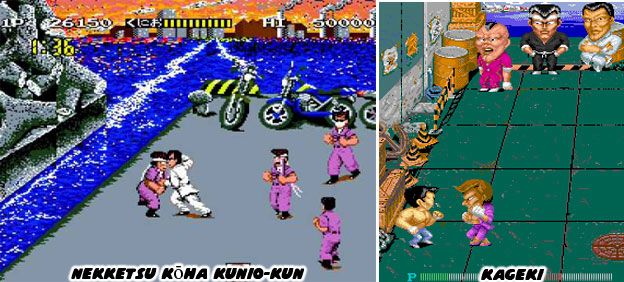
Taito published a different sort of bancho fighting game in 1988. Kageki featured a heroic street boxer taking on every member of a local gang. Just about every gang and delinquent archetype from Japanese manga and cinema was represented here. The chubby low-level goon, a slacker, a chisel-jawed heavy, a weasel-like henchman, the dirty fighter, and of course the super-cool gang leader. These characters included the various motorcycle and car freaks that identified with the bosozoku or "violent speed tribes" in Japan. Remember that the seminal AKIRA, the manga first published in 1982 by Katsuhiro Otomo started with the futuristic bosozoku gang lead by Kaneda and his rival The Clowns. Being a delinquent was not only cool, it turned out that a group of them could save the world. Anyhow the various tough guys from pop culture all had to be defeated in Kageki. If a player scored a knockout their opponent would be dropped down a manhole. It was easily the coolest way of disposing a body in a video game.
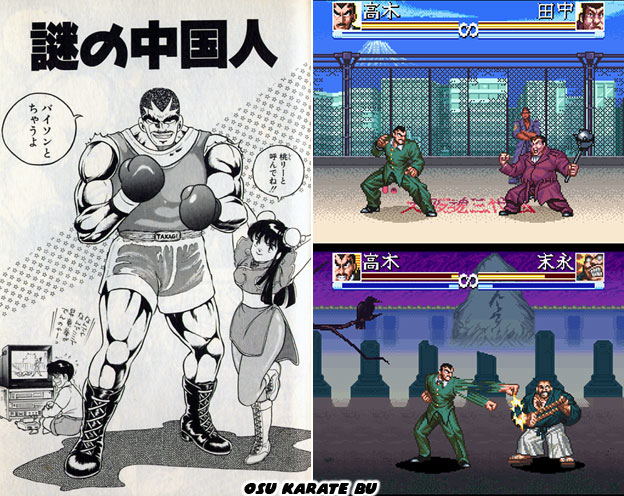
The bancho had a sort of peak in popularity in the mid to late '80s. One of the first breakout manga titles was Osu Karate Bu - "Karate Club" by Koji Takahashi. The series was first published in 1985 and ran through 1996. The story featured the mustached tough guy Takagi Yoshiyuki. He was the overseer of the various gangs that used to take part in his "club" which was really a front for organized no-holds-barred fighting tournaments. Think of it like a high school Fight Club where even mobsters and actual karate masters were allowed to compete. There was much more comedy and over-the-top fighters than the actual Fight Club movie of course. A young character named Matsushita Tadashi would become the most famous person in the series and end up being its narrator. When he started school he would get beat up all the time. He joined the karate club in the hopes that he would learn how to fight. He got even more beat up by the club members but over the years he grew stronger and learned how to fight back. The series hit a peak in 1994 when the manga was turned into a Super Famicom (Super Nintendo) fighting game by Culture Brain. During the rise of the fighting game genre Mr. Takahashi noticed that boxer M. Bison from Street Fighter II had an eery similar haircut to Takagi. He was sure to point it out when he created a parody cover in his comic.
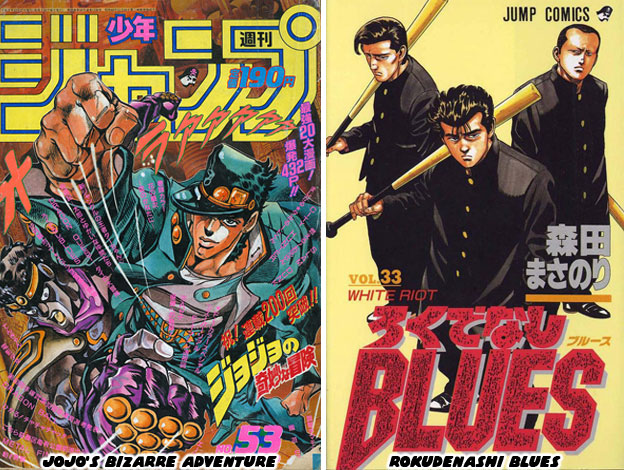
Young anti-heroes and the delinquents were made cool in AKIRA and Osu Karate Bu but those weren't the only series focused on outsider culture. Previously in manga, anime and live-action shows the heroes were straight-laced good guys. The outsider, the rebel of the group was still popular but was never meant to be a replacement for the main hero. All that changed when manga and anime began featuring more anti-heroes and more stories that weren't set on campy henshin or sentai characters like the Power Rangers. Possibly the hottest and strangest manga in the mid-'80s was JoJo's Bizarre Adventure. The series which began in 1986 revolved around Jotaro Kujo and his friends. Jotaro's uniform was a fashionable take on the gakuran, with a big gold chain punched through the collar, a decorated cap and multiple belts on designer slacks. When he and his friends battled they used supernatural abilities against all sorts of crazy-looking characters. The series by Hirohiko Araki was influenced by Western pop culture; character names included musical acts Chaka Khan, Ronnie James Dio, Cameo, ZZ Top, Mariah Carey, Iggy Pop and DEVO. And it featured characters and costumes inspired by international fashionistas. His hero and allies were far from the traditional bancho, the words that would best describe them would be colorful, flamboyant and eccentric. JoJo was on the extreme end of fantasy, yet there was another comic that was grounded in a more realistic world.
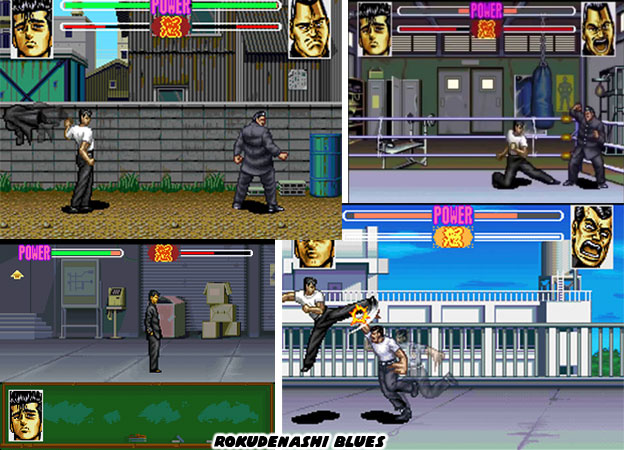
Rokudenashi Blues featured heavy hitter Taison Maeda. He was a scrappy boxer whose first name was reminiscent of Mike Tyson. Different spellings of course. Anyhow Rokudenashi Blues was as classic a bancho manga as there ever was. The series started in 1988 by Masanori Morita was a straightforward look at the life of delinquents trying to survive high school and of course the girls that loved them. There were many encounters with various gangs and other school troublemakers. The fights lasted several panels and the results of which would last for months. Unlike other manga where the heroes could be on the brink of death in one issue and then be perfectly fine the next Taison and his friends were left battered and bruised over the course of several story arcs. Jotaro and Taison were the types of heroes that school kids could identify with, making them very popular with young audiences. It only made sense that the bancho would turn up in fighting games a few years later as the audience began consuming different forms of entertainment. Osu Karate Bu found it's way to the Super Famicom in 1994 but so too did Rokudenashi Blues. Bandai developed and published the game. What made it unique was that the fights in the story mode happened the same order as the encounters did in the manga. This level of accuracy would be used in the Dragon Ball Z fighting games by Bandai as well.
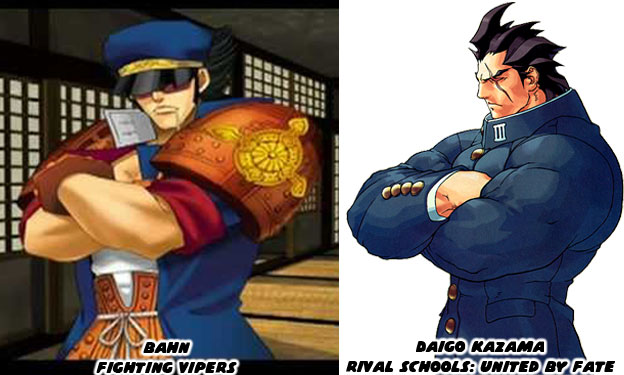
Fighting Vipers was a lesser-know Sega fighting game from 1995. It revolved around youth culture, with skateboarders, rock musicians and motorcycle thugs taking part in a tournament. The control and combo system were fairly easy to pick up and you could imagine that the game was meant to be the younger brother of Virtua Fighter, the more popular 3D fighter from the publisher. The main character in Fighting Vipers was 17-year-old Bahn. A large bruiser whose costume was modeled after Jotaro's. His costume was part gakuran and part samurai armor. He wasn't the only bancho to turn up in the genre. In 1997 Capcom released Rival Schools: United by Fate. That game was set entirely in a world where the top students, the most popular, or most delinquent from a half dozen schools also happened to be excellent fighters. I don't mean traditional fighters either, but more like young versions of the Street Fighter all-stars. A few characters wore traditional Japanese school uniforms but Daigo Kazama, the big brother of motorcycle rider Akira Kazama, was the leader of a gang and central to the plot of the game. He had been brainwashed and was going around attacking students and teachers alike. The other students had to figure out why and get to the bottom of the conspiracy. Daigo's long coat, spiky hair and nasty scar over his eye made him look like that baddest bancho there ever was.
The bancho was the hero that a new generation was following. They were the stars in the comics and cartoons and fans wanted to see them represented in fighting games. But the fighting game still had to do some evolving. The kung-fu films and comics of the late '70s and early '80s inspired the development of Street Fighter and the other first generation fighting games. The Japanese designers would try to create characters that had an international appeal, especially in the US where they could make lots of money in the arcade and home consoles. So they took influences from cult Western movies and mixed that look with the Japanese manga aesthetic. The results were characters with very strong looks. Karate fighters that wore the traditional gi, muay thai fighters in shorts, kung-fu masters in wushu clothes and literal street fighters that wore jeans and sneakers. This was what people expected to see. The bancho star wouldn't appear until later.
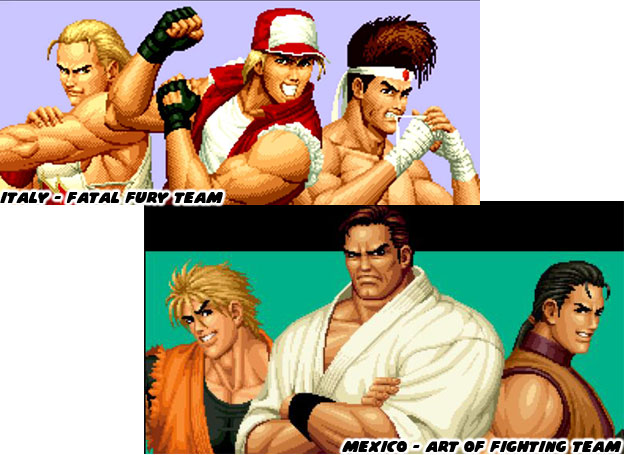
SNK was doing very well at telling the story through a fighting game. They had a gritty theme in the original Art of Fighting. You could almost imagine this game was based on a pulp '80s film. With its seedy villains, imaginative locations and twist ending. They also had the more animé friendly Fatal Fury, which also had a great story and over-the-top villains. By the mid-90s the studio knew that they had to come up with a radical new idea in order to compete against Capcom, Midway and the other studios that were red hot. That was when they decided to formalize the King of Fighters tournament in 1994 and create a game that united the various fighters. For fans of the first generation of fighters there would be both a team Fatal Fury and a team Art of Fighting. Each represented a nation, in this case Italy and Mexico respectively. SNK was not happy with the idea of Terry or Ryo being the solitary star of the game. They did not want fans to think the studio was telling them who were the better fighters, or who they should root for, they would let fans decide. To help make things interesting SNK went way back in their catalog of characters and brought back a few arcade pioneers.
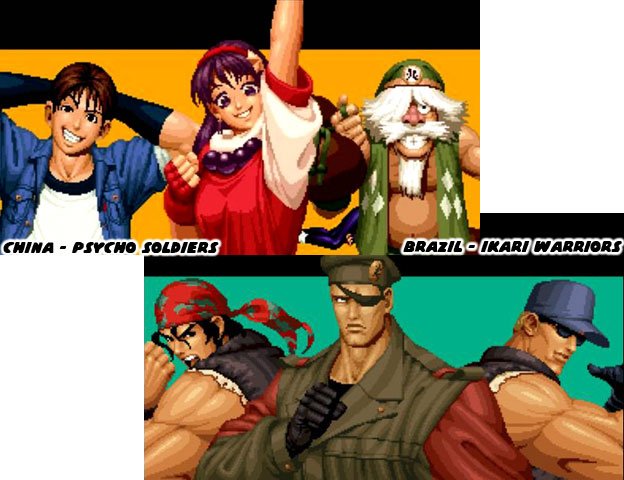
China was represented by a trio of Kung-Fu masters, the leader was a pink-haired Athena Asamiya. Her psychic powers lead to the state-sponsored team being known as the Psycho Soldiers. From Brazil there was a trio of mercenaries, two of the figures looked very familiar to arcade veterans yet the one with the eyepatch was new. It turned out that the guy with the blue baseball cap was Clark Still and the one with the red bandanna was Ralf Jones. The two were better known as the Ikari Warriors, an arcade title that shared the same name. It was one of the pioneering run-and-gun shooters in the arcade. The Ikari Warriors were a mix of Sylvester Stallone's Rambo and Arnold Schwarzenegger's Commando, they could topple any dictator with their nonstop barrage of weapons and combat skills. In the early game the characters wore a red headband or blue headband so players could tell them apart. The game was revolutionary because it featured an octagonal joystick that could be rotated to aim in different directions while running. Prior to that characters might have been able to shoot left, right or diagonally but the joystick had to be pointed in that direction as well. Gamers could suddenly strafe opponents while moving between cover. Seeing the mercs return as fighters was a welcome surprise. Perhaps they were the best brawlers in the KOF universe instead?
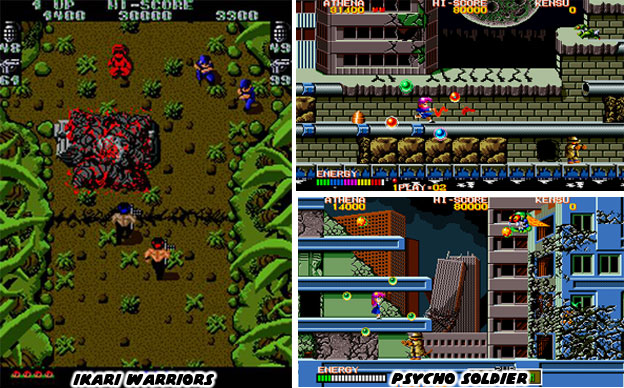
It turned out that the Chinese Athena and Sie Kensou had appeared previously as well. They were in a game called Psycho Soldier which didn't see much popularity in the US. It was a side-scrolling action title but instead of flying a spaceship as was the case with most side-scrollers this game had Athena and Sie using their psychic powers through the real world and underworld. The game was actually connected to a previous title called Athena. It was based on the Greek goddess and had players building her armor and fighting to reclaim Olympus. That game was an action platformer in the vein of Capcom's Black Tiger or Ghosts n' Goblins. The modern Athena was descended from the goddess. Both Ikari Warriors and Psycho Soldier were released in 1986 and both represented SNK's older and more cult-favorite titles. It was great that SNK was acknowledging their legacy and putting the various characters into one continuity. Yet something was missing. It was great to see the fighting game stars and other arcade stars introduced in a tag-team battle but the groups were found lacking. The studio needed to introduce a new team, or a couple of new teams that would represent the franchise and stand up to the stars from the other titles. These characters would have to become the next generation fighting icons. Once again the studio looked at pop culture for their inspiration. They had done what they could with classic movie heroes and villains and they needed to find something more contemporary. They found that the bancho was a hero they hadn't yet considered. An amazing rivalry would grow out of this character choice. We'll explore this story in the next entry. I hope to see you then! As always if you would like to sponsor me please visit my Patreon page and consider donating each month, even as little as $1 would help make bigger and better recordings and videos.

Another great example of gangs fight was surely Last Bronx by Sega. Still cool nowadays.
ReplyDeleteGood article, but the Jojo's Bizarre Adventure arc that starred Jotaro Kujo started in 1989 and was the 3rd one in the series.
ReplyDeleteyou are right my friend Luis pointed that out too. I should have been more careful because even the new one has similar bancho elements
Delete/yeah, when it comes to Bancho elements in Jojo's Bizarre Adventure, the 3rd arc ("Stardust Crusaders" that features Jotaro), the 4th arc ("Diamond is unbreakable" with Josuke Higashikata, which has a currently-airing Anime) and the 5th Arc ("Vento Aureo") all have the highschool delinquent aesthetic to some degree, though the last one tends to stray away from that quite a bit after the start.
ReplyDeleteIn truth, none of the others characters in Jojo's come close to Jotaro's influences in fighting game character design though, because even Sol Badguy in Guilty Gear has some poses and quotes that kind of reference Jotaro.
Weasel, thanks for filling in those details. There was something about the school aesthetic during that time. I should have also mentioned Yu Yu Hakusho had also borrowed a lot from the bancho.
Delete